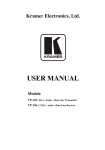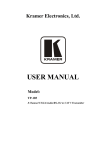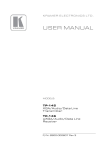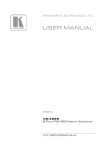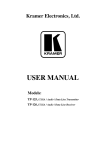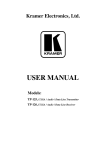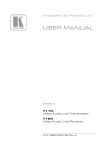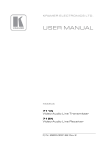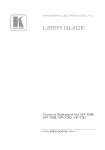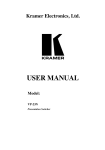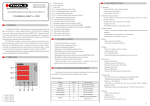Download USER MANUAL
Transcript
Kramer Electronics, Ltd. USER MANUAL Model: TP-185 8 Channel UXGA/Audio/RS-232 to CAT 5 Transmitter Contents Contents 1 2 2.1 3 3.1 4 5 6 6.1 6.2 6.3 6.4 7 Introduction 1 Getting Started 1 Quick Start 2 Overview 3 Shielded Twisted Pair/Unshielded Twisted Pair 3 Defining the TP-185 8 Channel UXGA/Audio/RS-232 to CAT 5 Transmitter 4 Installing the TP-185 in a Rack 6 Connecting and Configuring the TP-185 7 Connecting the TP-185 7 Connecting to the TP-185 via an RS-232 Connection 8 Connecting to the TP-185 via an RS-485 Connection 8 Connecting Multiple TP-185 Units via the RS-485 Bus 9 Setting the DIP-switches on the TP-185 10 7.1.1 7.1.2 7.1.3 7.1.4 7.1.5 Setting the RS-485 Bus Termination Enabling and Disabling the Reply Feature Setting the Reply Source or Machine Number Setting the RS-232/RS-485 Baud Rate DIP-switches Selecting Hardware/Software Mode 10 10 11 12 12 8 9 10 10.1 Wiring the Twisted Pair RJ-45 Connectors Technical Specifications Default Communication Parameters Kramer Communication Protocol 2000 13 14 14 15 Figures Figure 1: TP-185 Front and Rear Panels 4 Figure 2: Connecting the TP-185, 8 Channel UXGA/Audio/RS-232 to CAT 5 Transmitter7 9 Figure 3: Connecting Multiple TP-185 Units via RS-485 10 Figure 4: TP-185 DIP-switch RS-485 Termination 10 Figure 5: TP-185 Reply Enable and Disable DIP-switch 11 Figure 6: TP-185 Reply Source or Machine Number DIP-switches Figure 7: TP-185 Baud Rate DIP-switches 12 12 Figure 8: TP-185 Baud Rate Hardware/Software DIP-switch 13 Figure 9: UTP Connector Tables Table 1: TP-185 Front and Rear Panel Features Table 2: Hardware Mode Reply Source DIP-switch Setting Table 3: Software Mode RS-485 Machine Number DIP-switch Setting Table 4: Serial Port Baud Rate DIP-switch Setting 5 11 11 12 i Contents Table 5: UTP Connector Pinout Table 6: Technical Specifications of the TP-185 Table 7: TP-185 Communication Parameters Table 8: Protocol Command Definition Table 9: Instruction Codes for the TP-185 Table 10: Sample TP-185 Control Commands ii 13 14 14 15 16 16 KRAMER: SIMPLE CREATIVE TECHNOLOGY Introduction 1 Introduction Welcome to Kramer Electronics! Since 1981, Kramer Electronics has been providing a world of unique, creative, and affordable solutions to the vast range of problems that confront the video, audio, presentation, and broadcasting professional on a daily basis. In recent years, we have redesigned and upgraded most of our line, making the best even better! Our 1,000-plus different models now appear in 11 groups 1 that are clearly defined by function. Congratulations on purchasing your TP-185, 8 Channel UXGA/Audio/RS-232 to CAT 5 Transmitter, which is ideal for the following typical applications: • Transmission of video, audio and RS-232 signals for extended distances over standard STP/UTP cables • Multimedia and presentation source and acceptor selection The package includes the following items: • TP-185, 8 Channel UXGA/Audio/RS-232 to CAT 5 Transmitter • Power cord 2, rack “ears” and this user manual 3 2 Getting Started We recommend that you: • Unpack the equipment carefully and save the original box and packaging materials for possible future shipment • Review the contents of this user manual • Use Kramer high performance high-resolution cables 4 1 GROUP 1: Distribution Amplifiers; GROUP 2: Switchers and Matrix Switchers; GROUP 3: Control Systems; GROUP 4: Format/Standards Converters; GROUP 5: Range Extenders and Repeaters; GROUP 6: Specialty AV Products; GROUP 7: Scan Converters and Scalers; GROUP 8: Cables and Connectors; GROUP 9: Room Connectivity; GROUP 10: Accessories and Rack Adapters; GROUP 11: Sierra Products 2 We recommend that you use only the power cord that is supplied with this machine 3 Download up-to-date Kramer user manuals from http://www kramerelectronics com 4 The complete list of Kramer cables is available from http://www kramerelectronics com 1 Getting Started 2.1 Quick Start This quick start chart summarizes the basic setup and operation steps. 2 KRAMER: SIMPLE CREATIVE TECHNOLOGY Overview 3 Overview The TP-185 is a high performance, 8 channel VGA/UXGA1, audio and RS-232 to CAT 5 transmitter for high resolution video, stereo unbalanced audio and RS-232 signals. The CAT 5 outputs can be connected to any Kramer compatible TP receiver, for example, the TP-126. The TP-185 can also route data from the RS-232 or RS-485 port to any of the CAT 5 outputs. In particular, the TP-185, 8 Channel UXGA/Audio/RS-232 to CAT 5 Transmitter features: • Eight UXGA video inputs supporting HDTV and Component (YPbPr) signals • Eight stereo unbalanced audio inputs on 3.5mm mini jacks • Eight RJ-45 STP/UTP outputs • Transmission of RS232/RS-485 data from one input to any or all of the eight CAT 5 outputs, and one reply from the selected output The TP-185 can differentiate between RS-232/RS-485 commands that control the unit itself and commands that are destined for end-user equipment (see Section 7.1.5.2). The TP-185 is dependable, rugged, and fits into one vertical space (1U) of a standard 19” professional rack. To achieve the best performance: • Use only good quality connection cables 2 to avoid interference, deterioration in signal quality due to poor matching, and elevated noise levels (often associated with low quality cables). • Avoid interference from neighboring electrical appliances that may adversely influence signal quality, and position your Kramer TP-185 away from moisture, excessive sunlight and dust 3.1 Shielded Twisted Pair/Unshielded Twisted Pair We recommend that you use Shielded Twisted Pair (STP) cable. There are different levels of STP cable available, and we advise you to use the best quality STP cable that you can afford. Our non-skew-free cable, Kramer BC-STP is intended for analog signals where skewing is not an issue. For cases where there is skewing, our UTP skew-free cable Kramer BC-XTP, may be used. Bear in mind though, that we advise using STP cables where possible, since the compliance to electromagnetic interference was tested using those cables. Although Unshielded Twisted Pair (UTP) cable might be preferred for long range applications, the UTP cable should be installed far away from electric cables, motors and so on, which are prone to create electrical interference. However, since the use of UTP cable might cause inconformity to electromagnetic standards, Kramer does not commit to meeting the standard with UTP cable. 1 Up to and including WUXGA 1920 x 1200 resolution 2 Available from Kramer Electronics on our Web site at http://www kramerelectronics com 3 Defining the TP-185 8 Channel UXGA/Audio/RS-232 to CAT 5 Transmitter 4 Defining the TP-185 8 Channel UXGA/Audio/RS-232 to CAT 5 Transmitter Figure 1 and Table 1 define the front and rear panels of the TP-185, 8 Channel UXGA/Audio/RS-232 to CAT 5 Transmitter. Figure 1: TP-185 Front and Rear Panels 4 KRAMER: SIMPLE CREATIVE TECHNOLOGY Defining the TP-185 8 Channel UXGA/Audio/RS-232 to CAT 5 Transmitter Table 1: TP-185 Front and Rear Panel Features # 1 2 3 4 5 6 7 8 9 10 11 12 13 Feature POWER LED VIDEO INPUT 15-pin HD Connectors OUT STP/UTP RJ-45 Connectors AUDIO INPUT 3 5mm Mini Jacks RS-485 TERM DIP-switch Function Lights green when the unit is turned on 1 Connect to the VGA/UXGA video sources (from 1 to 8) Connect to the TP receivers (from 1 to 8) Connect to the unbalanced stereo audio sources (from 1 to 8) 2 Sets the termination of he RS-485 bus : ON for RS-485 bus termina ion with 120Ω (default), OFF for no RS-485 bus termination (see Sec ion 7.1.1) Reply DIP-switch 1 Enables and disables the Reply feature (see Section 7.1.2) Address DIP-switches 2, Determines the reply source (hardware mode) or machine 3 and 4 number (software mode) see Sec ion 7.1.3 SETUP DIP-switch Baud Rate DIP-switches Determines the serial port baud rate (see Section 7.1.4) 5, 6 and 7 Hardware/Software Determines whe her he data transmission path is set by DIP-switch 8 software or hardware (see Sec ion 7.1.5) AC Mains Connector Connect to the AC mains power AC Mains Fuse AC mains power fuse AC Mains Power Switch Turns the unit power ON or OFF RS-232 Terminal Block Connect to a PC or remote controller (see Section 6.4) RS-485 Terminal Block Pins B (–) and A (+) are for RS-485; Pin G (Ground) may be connected to he shield of he cable if required (see Sec ion 6 3) FACTORY RESET Button Press and hold while powering up the unit to reset the data transmission setup to its factory default value 3 (see Section 10) PROG Button For service use only 1 See item 9 2 The first and the last units on the RS-485 line should be terminated (ON) Other units should be unterminated (OFF), see Section 7 1 1 3 Turn the unit off using the power switch and then turn it on while pressing the Factory Reset button The unit will power up and load its memory with the factory default definitions 5 Installing the TP-185 in a Rack 5 Installing the TP-185 in a Rack This section describes what to do before installing in a rack and how to rack mount the TP-185. 6 KRAMER: SIMPLE CREATIVE TECHNOLOGY Connecting and Configuring the TP-185 6 Connecting and Configuring the TP-185 This section comprises connecting: • The TP-185 (see Section 6.1) • To the TP-185 via RS-232 (see Section 6.2) • To the TP-185 via RS-485 (see Section 6.3) • Multiple TP-185 units via RS-485 (see Section 6.4) 6.1 Connecting the TP-185 To connect 1 the TP-185, as illustrated in the example 2 in Figure 2: Figure 2: Connecting the TP-185, 8 Channel UXGA/Audio/RS-232 to CAT 5 Transmitter 1 You do not need to connect all inputs and outputs 2 Switch OFF the power on each device before connecting it to your TP-185 After connecting your TP-185, switch on its power and then switch on the power on each device DO NOT push in the rear panel Flash Program “PROG” button , it is only used for upgrading to the latest Kramer firmware 7 Connecting and Configuring the TP-185 1. Connect up to eight VGA/WUXGA computer graphics sources (for example, multimedia computers) to the Video INPUT 15-pin HD connectors. 2. Connect up to eight unbalanced stereo audio sources (for example, the audio source of the computer or a DAT player) to the eight AUDIO INPUT 3.5mm mini jacks. 3. Connect the eight OUT STP/UTP connectors to up to eight TP receivers. 4. If required, you can connect a PC and/or controller to the: RS-232 terminal block (see Section 6.2) RS-485 terminal block (see Section 6.3 and Section 6.4) 5. Connect the power cord 1 (not shown in Figure 2). 6.2 Connecting to the TP-185 via an RS-232 Connection To connect the RS-232 port on the TP-185 to an RS-232 device: 1. Connect the RS-232 Tx pin on the TP-185 to pin 2 (9-pin D-sub) on the RS-232 device 2. Connect the RS-232 Rx pin on the TP-185 to pin 3 (9-pin D-sub) on the RS-232 device 3. Connect the RS-232 G pin on the TP-185 to pin 5 (9-pin D-sub) on the RS-232 device 6.3 Connecting to the TP-185 via an RS-485 Connection You can operate the TP-185 via the RS-485 port from a distance of up to 1200m (3900ft) using a PC equipped with a card that provides an RS-485 port. To connect a PC or controller to the RS-485 port on the unit: 1. Connect the pins on the following ports: Connect the A(+) pin on the RS-485 port of the PC to the A pin on the RS-485 port on the rear panel of the TP-185 Connect the B(–) pin on the RS-485 port of the PC to the B pin on the RS-485 port on the rear panel of the TP-185 If required, connect the GND pin 2 on the RS-485 port of the PC to the G (ground) pin on the rear panel of the TP-185 2. If this is the only TP-185 on the RS-485 bus, set the RS-485 TERM DIP-switch (see Section 7.1.1) to ON (for RS-485 line termination with 120Ω). 1 We recommend that you use only the power cord that is supplied with this machine 2 For RS-485 communication, the ground is usually not connected between the devices When using a shielded cable, the shield may be grounded on one side 8 KRAMER: SIMPLE CREATIVE TECHNOLOGY Connecting and Configuring the TP-185 6.4 Connecting Multiple TP-185 Units via the RS-485 Bus You can connect up to 8 TP-185 units via the RS-485 bus with control from a PC or serial controller. To connect up to 8 TP-185 units via RS-485 (see Figure 3): 1. Connect the RS-485 terminal block of the first TP-185 to the RS-485 terminal block of the second TP-185, and so on (see Section 6.3), connecting all the TP-185 units via the RS-485 terminal blocks. 2. Set each TP-185 Machine number to be a unique number (see Section 7.1.3). 3. On the first and last TP-185 physical devices on the RS-485 bus, set the RS-485 TERM DIP-switch ON (terminating the RS-485 line at 120Ω, see Section 7.1.1). 4. On all other TP-185 units, ensure that the RS-485 Term DIP-switch is OFF. Figure 3: Connecting Multiple TP-185 Units via RS-485 9 Setting the DIP-switches on the TP-185 7 Setting the DIP-switches on the TP-185 The DIP-switches on the TP-185 perform the following functions: • RS-485 termination • Reply enable/disable • Reply machine number • Baud rate • Hardware/software mode Moving a DIP-switch down turns the switch on, moving it up turns the switch off. Note: Changing any DIP-switch requires that you cycle power on the TP-185 7.1.1 Setting the RS-485 Bus Termination The DIP-switch sets the RS-485 bus termination. Only the first and last physical device on the RS-485 bus must be terminated, all other devices must be un-terminated. Figure 4: TP-185 DIP-switch RS-485 Termination When DIP-switch 1 is: • OFF, the unit is un-terminated (default) • ON, the unit is terminated Note: DIP-switch 2 is not used. 7.1.2 Enabling and Disabling the Reply Feature DIP-switch 1 enables and disables the Reply feature. Figure 5: TP-185 Reply Enable and Disable DIP-switch 10 KRAMER: SIMPLE CREATIVE TECHNOLOGY Setting the DIP-switches on the TP-185 When DIP-switch 1 is: • Up, Reply is disabled (default) • Down (ON), Reply is enabled 7.1.3 Setting the Reply Source or Machine Number DIP-switches 2, 3 and 4 set either the reply source (in Hardware mode Table 2) or machine number (in Software mode Table 3). Figure 6: TP-185 Reply Source or Machine Number DIP-switches Table 2: Hardware Mode Reply Source DIP-switch Setting DIP-switch 2 3 4 Reply is taken from output 1 (default) OFF OFF OFF Reply is taken from output 2 ON OFF OFF Reply is taken from output 3 OFF ON OFF Reply is taken from output 4 ON ON OFF Reply is taken from output 5 OFF OFF ON Reply is taken from output 6 ON OFF ON Reply is taken from output 7 OFF ON ON Reply is taken from output 8 ON ON ON Reply Source Note: When there is more than one TP-185 attached to the RS-485 bus only one unit can have a reply path set. Table 3: Software Mode RS-485 Machine Number DIP-switch Setting Machine Number 1 2 3 4 DIP-switch 2 3 4 OFF ON OFF ON OFF OFF ON ON OFF OFF OFF OFF Machine Number 5 6 7 8 DIP-switch 2 3 4 OFF ON OFF ON OFF OFF ON ON ON ON ON ON When there is more than one TP-185 attached to the RS-485 bus each unit must have a unique machine number. 11 Setting the DIP-switches on the TP-185 7.1.4 Setting the RS-232/RS-485 Baud Rate DIP-switches DIP-switches 5, 6 and 7 set the serial port baud rate in both Hardware and Software modes according to Table 4. Note: In a multiple device configuration, all devices must be set to the same baud rate. Figure 7: TP-185 Baud Rate DIP-switches Table 4: Serial Port Baud Rate DIP-switch Setting Baud Rate 1200 2400 4800 9600 (default) 7.1.5 DIP-switch 5 6 7 OFF OFF OFF ON OFF OFF OFF ON OFF ON ON OFF DIP-switch 5 6 7 OFF OFF ON ON OFF ON OFF ON ON ON ON ON Baud Rate 19200 38400 57600 115200 Selecting Hardware/Software Mode DIP-switch 8 sets the operating mode to either Hardware or Software mode. Figure 8: TP-185 Baud Rate Hardware/Software DIP-switch When the DIP-switch is: • OFF, the unit is set to Hardware mode (default) • ON, the unit is set to Software mode 7.1.5.1 Hardware Mode In Hardware mode, the: • RS-232 data is passed from any input to all outputs • TP-185 routes the reply from the output port defined by the DIP-switches 2, 3 and 4 (see Section 7.1.2). For reliable operation, only one port can be defined 12 KRAMER: SIMPLE CREATIVE TECHNOLOGY Wiring the Twisted Pair RJ-45 Connectors 7.1.5.2 Software Mode In Software mode, the TP-185 routes the data and reply based on the Protocol 2000 commands received from the PC or other device connected to any of the inputs. The following example illustrates a typical command sequence. The destination and return paths to and from the end-user device are set (TP-185 control commands), then an end-user device command is sent to the defined destination. The TP-185 differentiates between the two types of commands and acts accordingly. The sequence is as follows: 1. Set destination path for command 2. Set return path 3. Send end-user command sequence 8 Wiring the Twisted Pair RJ-45 Connectors Table 5 and Figure 9 define the TP pinout using a straight pin-to-pin cable with RJ-45 connectors. When using STP cable, connect/solder the cable shield to the RJ-45 connector shield. Table 5: UTP Connector Pinout EIA /TIA 568A PIN EIA /TIA 568B Wire Color PIN Wire Color 1 Green/White 1 Orange/White 2 Green 2 Orange 3 Orange/White 3 Green/White 4 Blue 4 Blue 5 Blue/White 5 Blue/White 6 Orange 6 Green 7 Brown/White 7 Brown/White 8 Brown 8 Brown Pair 1 4 and 5 Pair 1 4 and 5 Pair 2 3 and 6 Pair 3 1 and 2 Pair 2 Pair 3 1 and 2 3 and 6 Pair 4 7 and 8 Pair 4 7 and 8 1 2 34 56 78 1 2 4 5 78 36 Figure 9: UTP Connector 13 Technical Specifications 9 Technical Specifications Technical specifications of the TP-185 are shown in Table 6. Table 6: Technical Specifications 1 of the TP-185 INPUTS: OUTPUTS: RESOLUTION: RANGE: MAX. OUTPUT LEVEL: CONTROLS: SERIAL BAUD RATE: SERIAL MODE: BANDWIDTH: S/N RATIO: TOTAL GAIN: COUPLING: AUDIO THD + NOISE: POWER SOURCE: DIMENSIONS: WEIGHT: ACCESSORIES: 8 UXGA on 15-pin HD connectors (VGA through WUXGA, supporting HDTV and Component YPbPr signals) 8 unbalanced stereo audio 3.5mm mini jacks 8 TP on RJ-45 connectors Up to WUXGA (1920 x 1200) Up to 100m (328ft) VIDEO: 1.6Vpp AUDIO: 2.3Vpp RS-232 3 pin terminal block RS-485 3 pin terminal block Up to 19200kbps Full-duplex AUDIO: 20Hz to 20kHz @0.5dB AUDIO: <-80dB Audio: 0dB Audio: AC Audio: <0.03% 100-240V AC, 16VA 48 26cm x 19.1cm x 1U (19" x 7 52" x 1U) W, D, H 3.8kg (8.4lbs) approx Power cord, Windows®-based control software, rack “ears” 10 Default Communication Parameters Table 7 lists the TP-185 default communication parameters. Table 7: TP-185 Communication Parameters RS-232 Protocol 2000 Baud Rate: Data Bits: Stop Bits: Parity: Command Format: Example (Output 1 to Input 1): 9600 8 1 None HEX 0x01, 0x81, 0x81, 0x81 1 Specifications are subject to change without notice 14 KRAMER: SIMPLE CREATIVE TECHNOLOGY Default Communication Parameters 10.1 Kramer Communication Protocol 2000 The RS-232/RS-485 Protocol 2000 uses four bytes of information as shown in Table 8. The data rate is set by the DIP-switches (see Table 4), with no parity, 8 data bits and 1 stop bit. Table 8: Protocol Command Definition MSB LSB DESTINATION INSTRUCTION 0 D N5 N4 N3 N2 N1 N0 7 6 5 4 3 2 1 0 1st byte INPUT 1 6 I5 I4 I3 I2 I1 I0 7 6 5 4 3 2 1 0 1 O6 O5 O4 O3 O2 O1 O0 7 6 5 4 3 2 1 0 1 OVR X M4 M3 M2 M1 M0 7 6 5 4 3 2 1 0 2nd byte OUTPUT 3rd byte MACHINE NUMBER 4th byte Bit 7 – Defined as 0 1st BYTE: D – “DESTINATION”: 0 - for sending information to the switchers (from the PC); 1 - for sending to the PC (from the switcher) N5 N0 – “INSTRUCTION” The function that is to be performed by the switcher(s) is defined by the INSTRUCTION (6 bits) Similarly, if a function is performed via the machine’s keyboard, then these bits are set with the INSTRUCTION NO , which was performed The instruction codes are defined according to the table below (INSTRUCTION NO is the value to be set for N5 N0) 2nd BYTE: Bit 7 – Defined as 1 I6 I0 – “INPUT” When switching (ie instruction codes 1 and 2), the INPUT (7 bits) is set as the input number which is to be switched Similarly, if switching is done via the machine’s front-panel, then these bits are set with the INPUT NUMBER which was switched For other operations, these bits are defined according to the table 3rd BYTE: Bit 7 – Defined as 1 O6 O0 – “OUTPUT” When switching (ie instruction codes 1 and 2), the OUTPUT (7 bits) is set as the output number which is to be switched Similarly, if switching is done via the machine’s front-panel, then these bits are set with the OUTPUT NUMBER which was switched For other operations, these bits are defined according to the table 4th BYTE: Bit 7 – Defined as 1 Bit 5 – Don’t care OVR – Machine number override M4 M0 – MACHINE NUMBER Used to address machines in a system via their machine numbers When several machines are controlled from a single serial port, they are usually configured together with each machine having an individual machine number If the OVR bit is set, then all machine numbers will accept (implement) the command, and the addressed machine will reply For a single machine controlled via the serial port, always set M4 M0 = 1, and make sure that the machine itself is configured as MACHINE NUMBER = 1 15 Default Communication Parameters Table 9: Instruction Codes for the TP-185 INSTRUCTION # DESCRIPTION DEFINITION FOR SPECIFIC INSTRUCTION INPUT NOTE OUTPUT 2C CONTROLS THE STATUS OF A PORT 0–close 1–open Output bit: O0–O5 = output # or 0 for all outputs O6–0 = Tx 1 = Rx 1, 2, 4, 5 2D READS THE STATUS OF A PORT 0–open Output bit: O0–O5 = output # O6–0 = Tx; 1 = Rx 2, 3, 4, 5 Note: All values in the table are hexadecimal, unless otherwise stated NOTES on Table 9: NOTE 1 – When the PC sends this command, if the instruction is valid the unit replies by sending the PC the same 4 bytes that it was sent (except for the first byte where the Destination bit is set high) NOTE 2 – If O6 = 0 (Tx) – This command defines/reads the definition of the output # (1, 2 or3) to pass the RS-232/Direct command from any input In this case the instruction does not modify previously set output numbers, allowing the setting of multiple outputs for the Direct command If O6 = 1 (Rx), the command defines/reads the definition of the output # (1, 2 or 3) to pass the reply from the output to inputs In this case, the instruction resets a previously set output number, preventing the setting of multiple outputs for the reply NOTE 3 – The reply to this command is as follows: The same command and output codes as were sent are returned, and the input is assigned the value of the parameter that was read The reply is per the definitions in command 44 NOTE 4 – At initial power-on or on reception of command 44 or 45, any received bytes are analyzed to see whether it is a command 44 or 45 If not, it is transmitted to the output based on the existing setup If the analyzed bytes are a command 44 or 45, the unit waits for the other 3 bytes and interprets them as a Protocol 2000 command The command is executed if relevant to this machine number or discarded if not NOTE 5 – This command works only when the unit is configured for Software mode Table 10: Sample TP-185 Control Commands Command 16 Description Reply 2C 80 80 81 Close all output ports for direct command 6C 80 80 81 2C 80 C0 81 Close all output ports for reply command 6C 80 C0 81 2C 81 82 81 Open port 2 for direct command 6C 81 82 81 2C 81 C1 81 Open port 1 for reply command 6C 81 C1 81 2D 80 81 81 Check status of port 1 for direct command. Port is closed 6D 80 81 81 2D 80 82 81 Check status of port 2 for direct command. Port is open 6D 81 82 81 2D 80 C1 81 Check status of port 1 for reply command. Port is open 6D 81 C1 81 2D 80 C2 81 Check status of port 2 for reply command. Port is closed 6D 80 C2 81 KRAMER: SIMPLE CREATIVE TECHNOLOGY LIMITED WARRANTY Kramer Electronics (hereafter Kramer) warrants this product free from defects in material and workmanship under the following terms HOW LONG IS THE WARRANTY Labor and parts are warranted for seven years from the date of the first customer purchase WHO IS PROTECTED? Only the first purchase customer may enforce this warranty WHAT IS COVERED AND WHAT IS NOT COVERED Except as below, this warranty covers all defects in material or workmanship in this product The following are not covered by the warranty: 1 Any product which is not distributed by Kramer, or which is not purchased from an authorized Kramer dealer If you are uncertain as to whether a dealer is authorized, please contact Kramer at one of the agents listed in the Web site www kramerelectronics com 2 Any product, on which the serial number has been defaced, modified or removed, or on which the WARRANTY VOID IF TAMPERED sticker has been torn, reattached, removed or otherwise interfered with 3 Damage, deterioration or malfunction resulting from: i) Accident, misuse, abuse, neglect, fire, water, lightning or other acts of nature ii) Product modification, or failure to follow instructions supplied with the product iii) Repair or attempted repair by anyone not authorized by Kramer iv) Any shipment of the product (claims must be presented to the carrier) v) Removal or installation of the product vi) Any other cause, which does not relate to a product defect vii) Cartons, equipment enclosures, cables or accessories used in conjunction with the product WHAT WE WILL PAY FOR AND WHAT WE WILL NOT PAY FOR We will pay labor and material expenses for covered items We will not pay for the following: 1 Removal or installations charges 2 Costs of initial technical adjustments (set-up), including adjustment of user controls or programming These costs are the responsibility of the Kramer dealer from whom the product was purchased 3 Shipping charges HOW YOU CAN GET WARRANTY SERVICE 1 2 3 To obtain service on you product, you must take or ship it prepaid to any authorized Kramer service center Whenever warranty service is required, the original dated invoice (or a copy) must be presented as proof of warranty coverage, and should be included in any shipment of the product Please also include in any mailing a contact name, company, address, and a description of the problem(s) For the name of the nearest Kramer authorized service center, consult your authorized dealer LIMITATION OF IMPLIED WARRANTIES All implied warranties, including warranties of merchantability and fitness for a particular purpose, are limited in duration to the length of this warranty EXCLUSION OF DAMAGES The liability of Kramer for any effective products is limited to the repair or replacement of the product at our option Kramer shall not be liable for: 1 Damage to other property caused by defects in this product, damages based upon inconvenience, loss of use of the product, loss of time, commercial loss; or: 2 Any other damages, whether incidental, consequential or otherwise Some countries may not allow limitations on how long an implied warranty lasts and/or do not allow the exclusion or limitation of incidental or consequential damages, so the above limitations and exclusions may not apply to you This warranty gives you specific legal rights, and you may also have other rights, which vary from place to place NOTE: All products returned to Kramer for service must have prior approval This may be obtained from your dealer This equipment has been tested to determine compliance with the requirements of: EN-50081: EN-50082: CFR-47: "Electromagnetic compatibility (EMC); generic emission standard Part 1: Residential, commercial and light industry" "Electromagnetic compatibility (EMC) generic immunity standard Part 1: Residential, commercial and light industry environment" FCC* Rules and Regulations: Part 15: “Radio frequency devices Subpart B Unintentional radiators” CAUTION! Servicing the machines can only be done by an authorized Kramer technician Any user who makes changes or modifications to the unit without the expressed approval of the manufacturer will void user authority to operate the equipment Use the supplied DC power supply to feed power to the machine Please use recommended interconnection cables to connect the machine to other components * FCC and CE approved using STP cable (for twisted pair products) 17 For the latest information on our products and a list of Kramer distributors visit www.kramerelectronics.com where updates to this user manual may be found. We welcome your questions, comments, and feedback. Safety Warning: Disconnect the unit from the power supply before opening/servicing. Caution Kramer Electronics, Ltd. Web site: www kramerelectronics.com E-mail: [email protected] P/N: 2900-000612 REV 2





















